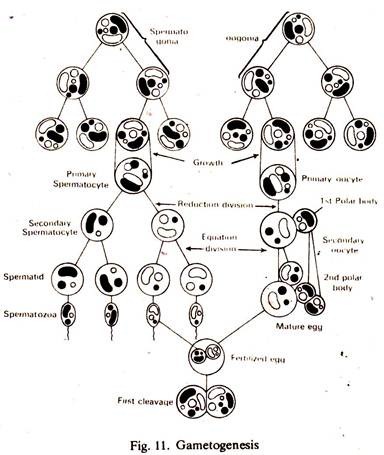In this article we will discuss about the process of gametogenesis in animals.
The series of changes through which the germinal epithelial cells pass to produce germ cells or gametes is called gametogenesis (Fig. 11). The development of eggs is oogenesis and that of the sperm is spermatogenesis. The phases of development in both the gametes are essentially similar.
Spermatogenesis:
1. It occurs in the testes. The walls of the seminiferous tubules of vertebrates contain primordial germ cells.
ADVERTISEMENTS:
2. The primordial germ cells begin to enlarge with increased metabolism and undergo mitotic division, and produce spermatogonia.
3. The spermatogonium divides meiotically (first meiosis) resulting in two spermatocytes.
4. Due to second meiotic division (mitosis) of spermatocyte four haploid-spermatids are formed.
5. Spermatids metamorphose to spermatozoa. This is spermiogenesis.
ADVERTISEMENTS:
(a) In this process spermatid increases in size; centriole divides into two; distal centriole forms the main axis of the tail the axial filament is surrounded by a fibre coat; mitochondria form a spiral sheath; golgi complex forms acroblast and give rise to acrosome.
6. The mature spermatozoon has three distinct zones head, trunk and tail. It can move actively in fluid.
Oogenesis:
1. It occurs in the ovary. The phases of division in multiplication are similar to those in spermatogenesis.
2. The primary germ cells of the ovary undergo several mitotic divisions to produce oogonia.
ADVERTISEMENTS:
3. The oogonium gives rise to primary oocytes mitotically.
4. A primary oocyte undergoes first meiotic division and produces one large secondary oocyte and one small first polar body or polocyte.
5. The oocyte and the polocyte divide mitotically (second meiotic division). The oocyte produces one large ootid and one small second polar body and the polocyte two polar bodies.
6. In oogenesis one haploid ootid and three polar bodies are formed. On maturity, the ootid is transformed into ovum.
Fertilization:
Fertilization is complete fusion of sperm and ovum except the chromosomes, resulting in a single diploid cell, the Zygote. The union of the nuclei of male and female gametes is karyogamy and that of their cytoplasm isplasmogamy.
The steps in fertilization are:
I. Approach of the spermatozoon to the egg:
(a) By chemotactic movement the sperm swims towards the egg.
(b) The jelly coat of the egg produces fertilizin and the sperms produce antifertilizin.
ADVERTISEMENTS:
(c) The fertilizin and the antifertilizin combine to form an initial bond to facilitate penetration of spermatozoon into the egg.
II. Penetration of the sperm:
(a) The bound or agglutinated spermatozoon produces an enzyme, lysine, which dissolves egg membranes in the local area and clear the path for spermatozoon to reach the egg surface.
(b) The acrosomal filament is pushed through the jelly and vitelline membrane, and touches the surface membrane of the egg cytoplasm.
III. Reaction in egg during sperm penetration:
(a) Coming in contact with the acrosomal filament the egg cytoplasm bulges forward to produce a conical projection, the fertilization cone.
(b) It gradually engulfs the spermatozoon and carries it inward.
(c) Simultaneously profound cortical reaction occurs in the cytoplasm.
(d) Immediately after penetration of the spermatozoon the vitelline membrane separates from the plasma membrane. The vitelline membrane thickens and forms the fertilization membrane.
(e) The cortical granules swell, become liquified and the fluid is released in the space between egg cytoplasm and fertilization membrane.
IV. Behaviour of sperm within the ovum:
(a) The head and middle piece enter the egg cytoplasm but the tail is left outside.
(b) The egg completes its meiosis immediately and loses the centriole.
(c) The sperm rotates 180° and its middle part comes to the front end. The path along which the sperm moves within the egg is known as fertilization path.
(d) The egg pronucleus moves to the periphery and the movement of the sperm is oriented to it. This is copulation path.
(e) The sperm pronucleus swells up. The centrosome and the centriole in the middle piece form aster around the two pronuclei.
(f) The sperm centriole divides into two, move to the poles being connected by fibres.
(g) The nuclear membranes disappear, the chromosomes of the male and female pronuclei are arranged in the equator of the spindle.
(h) It is similar to metaphase plate of meiosis and immediately followed by the cleavage of the zygote.
Importance of Fertilization:
(a) The sperm entry activates the secondary oocyte to complete its maturation division.
(b) Restores diploid number of chromosomes and recombines the maternal and paternal genetic materials.
(c) Evokes development and cleavage of egg to form a complete organism.
